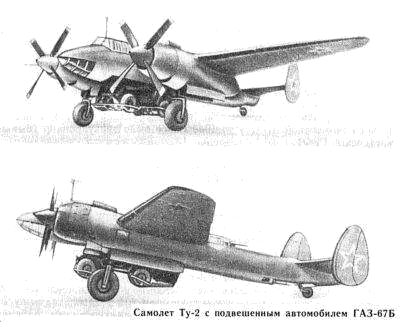Series
production started in February 1942 under designation ANT-60.
Shortly production was interrupted because catastrophic
shortages of front line fighters. Restarted in April 1943.
Originally Tu-2 served as front line and dive bomber. But
during long career it got more assignments.
Production continued until 1952 (2527 built), in Soviet
service until 1955.
The Tu-2 was
the USSR's third (historically) important twin-engined bomber
(after the Il-4 and Pe-2), and brought A.N.Tupolev back into
favour after a period of detention.
Heavy armament, powerful engines and incredible construction
strength allowed the crew after dropping bombs to turn back
and engage... enemy fighters.
Tu-2 was a mid-wing monoplane with large bomb bay under the
wing and twin tails. Production aircraft differed slightly
from each other by nose section shape and size, except
long-range versions (those had noticeably larger wing and tail
surfaces). Standard crew included pilot (in the front
cockpit), navigator (behind him), gunner and radio
operator/gunner in rear cockpit behind the wing. Long-range
variants sometimes had crew of five, in some missions crew was
cut to 2-3.
Bomb load was 1000kg inside the fuselage and 1000kg
externally. Tu-2 was often used in overload configuration,
carrying up to 4000kg of bombs. Maximum bomb calibre - 1000kg.
Normal armament included pair of 20mm ShVAK cannons in the
wing roots and 3...5 7.62mm ShKAS in three (navigator, gunner,
operator/gunner) defensive positions. Those were replaced by
heavy 12.7mm UBT machineguns. Optional RS-132 launchers could
be carried under the wing (up to 10). In later modifications
(including the most built) those launchers were deleted.
Since 1946 several Tu-2 were converted for special research
goals. In-flight study of rocket and jet engines was performed
on specially equipped Tu-2 'Flying Lab' (Letauschaja
Laboratorija).

Tu-2LL
In 1948
detailed study of de-icing devices was carried out. Rubber
strips, liquid and electric heating systems were evaluated.
They worked fine but were found insufficiently robust (poor
rubber quality). Proper choice of propeller (3.6m diameter
AV-5V-21 was finally selected) allowed to keep flying
characteristic unchanged with the same engines, while weight
of empty aircraft was increased.
To support paratroop operations one Tu-2 was modified to carry
and deploy by parachute a GAZ-67B light truck. Vehicle was
installed on special cage and half-hidden in the bomb bay. Bay
doors were removed. Deployment procedure was worked out, but
performance degradation (speed down to 378km/h and ceiling
down to 6000m) turned to be unacceptable. Conclusion was made
that special fairing is needed to use Tu-2 for this purpose.
Project was abandoned, because larger transport aircraft had
an obvious advantages.

Tu-2 with GAZ-67B light truck in the bomb bay.
During WWII
blimp-supported nets were widely used as anti-bomber defence.
To cut through hanging wires special 'Paravan' modification
was built. It carried 6m nose cone (light aluminium
monocoque), propeller protection 13.5mm wires from the cone
tip to wingtips and wing-tip mounted blades. To compensate for
the cone and wires weight, 150kg balance was added to the
tail.
Since this special aircraft carried no bombs, performance did
not suffer. 'Paravan' aircraft could accompany bomber
formations. Two were built and flown in September 1944.
Finally found unnecessary.
Specifications
Year
deployed
Wing span, m
Lenght, m
Height, m
Wings area, m2
Weight, kg
empty aircraft
normal take-off
Engine
Power, hp
Maximum speed, km/h
Cruising speed, km/h
Range, km
Rate of climb, m/min
Service ceiling, m
Crew
Armament:
|
1941
18.86
13.80
4.55
48.80
7474
11360
2 PE ASh-82FNV
2 У 1850
550
486
1400-2500
588
9500-10970
4
2 20-mm cannons ShVAK ,
3 12,7-mm machine-guns UBT
Bombs - 1000 kg , Maximum - up to 4000 kg
|
|
